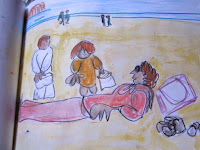Read in the New York Times, Thursday, november 22, 2018 about BRUEGHEL (le Vieux) : « A leading painter of the Northern Renaissance, known for works like « The tower of Babel », « The Peasant Wedding » and « the Triumph of Death », BRUEGEL created meticulously detailed, chaotic worlds. They parodied religious themes, mocked piousness, presented death and destruction in surpringly realistic detail and elevated peasants to central roles. » « elevated peasants to central roles », WAOW ! Well, at those times, peasants constituted the majority of the population, so if you're a painter that paints what he sees so you paint peasants !
BRUEGHEL represents scene of the Bible and of the mythology not in a chimeric unknown country but within his daily world it means peasants, merchants, priest and drunkers. So, for the fall of Icare, we just see a leg emerging of the sea as well as on the berge people's doing the things they used to do taking no attention of who's just falling in the sea . It means, all what mythology and religion talk about is what happened for real in our daily life but among a million of things that happened in the same time and among a million of people... That what BRUEGHEL talks about. « tout ce qui est humain ne m'est étranger » he could have said with MONTAIGNE, that's why on his painting, men have erection or pull some shit out of their hass, cause that's part of the human condition. Beauty and Uglyness are just side by sidein a farandole, it's part of the same thing, Death and life, blablabla. Nobody « elevated » no one there...
Find in the « Larousse des grands peintres », édition de 1976, dans la notice sur BRUEGHEL « Van
MANDER apporte que BRUEGEL, avant sa mort, avait détruit un certain nombre de ses dessins pour épargner des ennuis à sa veuve. On en a conclu que le peintre était non seulement un intellectuel individualiste, mais aussi un idéaliste épris de liberté politique, se révoltant contre la politique néfaste de Philippe II en Flandre. Il est vrai que certains éléments de ses tableaux sont des reflets de situations de son époque, mais si BRUEGEL a rendu avec objectivité des détails pittoresques de la vie de son temps, c'est qu'il ne pouvait faire autrement ! Il semble exagéré cependant de vouloir y chercher des allusions et des parodies politiques et religieuses de caractère « engagé » car ces sortes de provocations n'auraient jamais été admises en son temps et d'ailleurs ne correspondent pas avec la mentatité et le tempérament de BRUEGHEL. »
MANDER apporte que BRUEGEL, avant sa mort, avait détruit un certain nombre de ses dessins pour épargner des ennuis à sa veuve. On en a conclu que le peintre était non seulement un intellectuel individualiste, mais aussi un idéaliste épris de liberté politique, se révoltant contre la politique néfaste de Philippe II en Flandre. Il est vrai que certains éléments de ses tableaux sont des reflets de situations de son époque, mais si BRUEGEL a rendu avec objectivité des détails pittoresques de la vie de son temps, c'est qu'il ne pouvait faire autrement ! Il semble exagéré cependant de vouloir y chercher des allusions et des parodies politiques et religieuses de caractère « engagé » car ces sortes de provocations n'auraient jamais été admises en son temps et d'ailleurs ne correspondent pas avec la mentatité et le tempérament de BRUEGHEL. »
So as we know, History of Arts is not a science, the important point is that the pictures could be seen by each one who can make his/her own idea by confronting the image of the pictures to the images in his/her mind and memory. Human mind and memory...
Article « Peeling back the paint to uncover Breugel's secrets », New-York times international, thursday november 22, 2018.





Commentaires
Enregistrer un commentaire